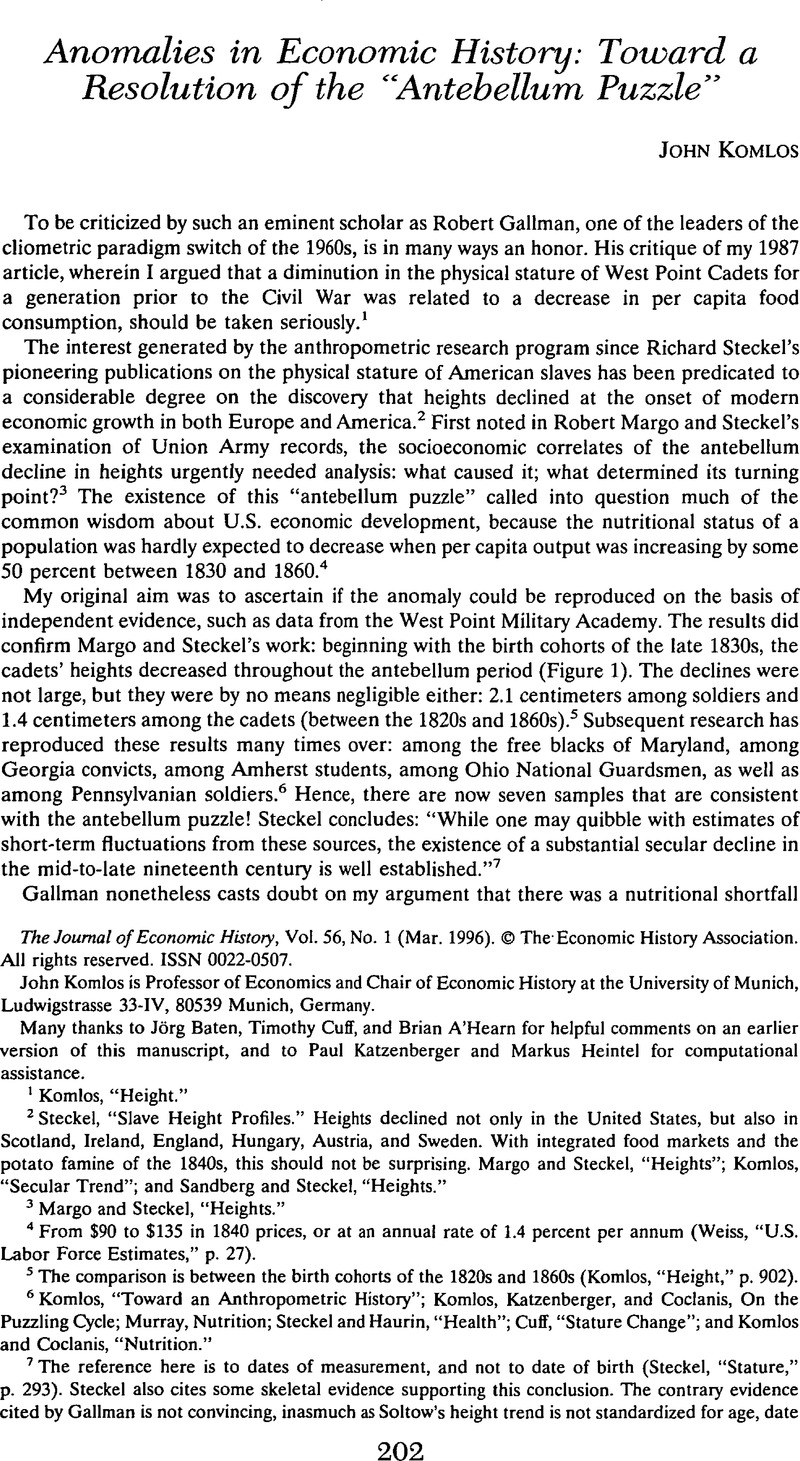Crossref Citations
This article has been cited by the following publications. This list is generated based on data provided by Crossref.
Komlos, John
and
Coclanis, Peter
1997.
On the Puzzling Cycle in the Biological Standard of Living: The Case of Antebellum Georgia.
Explorations in Economic History,
Vol. 34,
Issue. 4,
p.
433.
Haines, Michael R.
1998.
Estimated Life Tables for the United States, 1850–1910.
Historical Methods: A Journal of Quantitative and Interdisciplinary History,
Vol. 31,
Issue. 4,
p.
149.
Van Zanden, Jan Luiten
2000.
The Great Convergence from a West-European Perspective: Some Thoughts and Hypotheses.
Itinerario,
Vol. 24,
Issue. 3-4,
p.
9.
Baten, Jörg
and
Murray, John E.
2000.
Heights of Men and Women in 19th-Century Bavaria: Economic, Nutritional, and Disease Influences.
Explorations in Economic History,
Vol. 37,
Issue. 4,
p.
351.
Murray, John E.
2000.
Marital protection and marital selection: Evidence from a historical-prospective sample of American men.
Demography,
Vol. 37,
Issue. 4,
p.
511.
Haines, Michael R.
2001.
The urban mortality transition in the united states, 1800-1940.
Annales de démographie historique,
Vol. n o 101,
Issue. 1,
p.
33.
Lang, Stefan
and
Sunder, Marco
2003.
Non-parametric regression with BayesX: a flexible estimation of trends in human physical stature in 19th century America.
Economics & Human Biology,
Vol. 1,
Issue. 1,
p.
77.
van Zanden, Jan Luiten
2003.
Rich and poor before the Industrial Revolution: a comparison between Java and the Netherlands at the beginning of the 19th century.
Explorations in Economic History,
Vol. 40,
Issue. 1,
p.
1.
Delajara, Marcelo
2004.
Economic Development and the Quality of Life of Children.
Revista de Historia Económica / Journal of Iberian and Latin American Economic History,
Vol. 22,
Issue. 1,
p.
13.
Komlos, John
and
Baten, Jörg
2004.
Looking Backward and Looking Forward.
Social Science History,
Vol. 28,
Issue. 2,
p.
191.
Sunder, Marco
2004.
The height of Tennessee convicts: another piece of the “antebellum puzzle”.
Economics & Human Biology,
Vol. 2,
Issue. 1,
p.
75.
Komlos, John
2004.
How to (and How Not to) Analyze Deficient Height Samples.
Historical Methods: A Journal of Quantitative and Interdisciplinary History,
Vol. 37,
Issue. 4,
p.
160.
Alter, George
2004.
Height, frailty, and the standard of living: Modelling the effects of diet and disease on declining mortality and increasing height.
Population Studies,
Vol. 58,
Issue. 3,
p.
265.
Craig, Lee A.
Goodwin, Barry
and
Grennes, Thomas
2004.
The Effect of Mechanical Refrigeration on Nutrition in the United States.
Social Science History,
Vol. 28,
Issue. 2,
p.
325.
Salvatore, Ricardo D.
2004.
Stature decline and recovery in a food-rich export economy: Argentina 1900–1934.
Explorations in Economic History,
Vol. 41,
Issue. 3,
p.
233.
Carson, Scott Alan
2005.
The biological standard of living in 19th century Mexico and in the American West.
Economics & Human Biology,
Vol. 3,
Issue. 3,
p.
405.
Sunder, Marco
and
Woitek, Ulrich
2005.
Boom, bust, and the human body: Further evidence on the relationship between height and business cycles.
Economics & Human Biology,
Vol. 3,
Issue. 3,
p.
450.
Henderson, R. Max
2005.
The bigger the healthier: Are the limits of BMI risk changing over time?.
Economics & Human Biology,
Vol. 3,
Issue. 3,
p.
339.
Guntupalli, Aravinda Meera
and
Baten, Joerg
2006.
The development and inequality of heights in North, West, and East India 1915–1944.
Explorations in Economic History,
Vol. 43,
Issue. 4,
p.
578.
Salvatore, Ricardo D.
2007.
Heights, Nutrition, and Well-Being in Argentina, ca. 1850–1950. Preliminary Results.
Revista de Historia Económica / Journal of Iberian and Latin American Economic History,
Vol. 25,
Issue. 1,
p.
53.



